Road cycling is not a sport for the faint-hearted – or the casually dressed. Enter Gerard Thomas of ELEVEN vélo, who we met via his insightful comments right here on our blog. Gerard runs a WooCommerce store specializing in bespoke merino cycling wear for the discerning and experienced cyclist.
In chatting further with Gerard, we discovered him to be a rather brilliant Australian entrepreneur with over fifteen years of experience in ecommerce. That’s about as long as an ecommerce CV gets.
Read on for the story of how ELEVEN vélo became a leading online destination. You’ll also get Gerard’s tips for selling online, including less-is-more SEO tweaks to double organic traffic, product page advice and an innovative approach to content involving Instagram mash-ups.
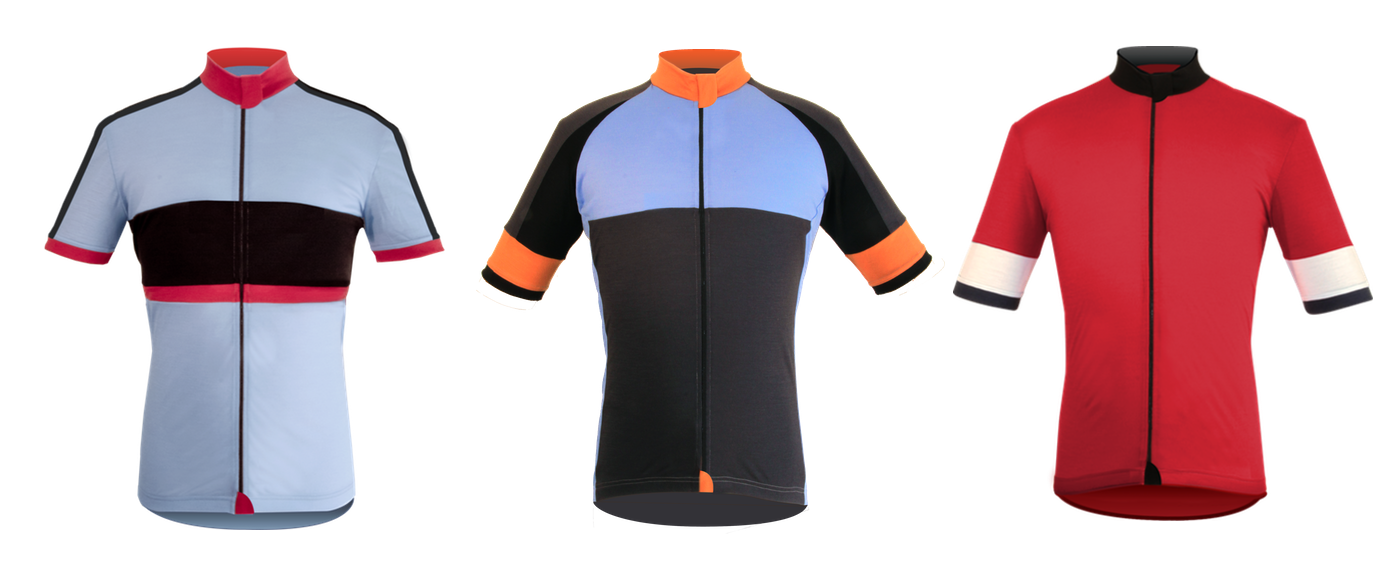
Starting when ecommerce was wet behind the ears
↑ Back to topGerard’s eCommerce journey began in 1999 when he stepped in to save an ailing site for a client who became a longtime friend. Back then, the eCommerce scene was worlds different; forget options for how to sell online, doing it at all was a feat!
The site Gerard took over sold high-end computer bags. They ended up plugging into a “boxed” backend that did all the transacting — the front end was an HTML website — and gradually figured out what was needed to drive online sales, including high-quality photography and well-worded text. It was so well done that a lecturer at Stanford used their website as a case study of how eCommerce should be done!
In these early days of experimenting, Gerard developed firm ideas of what he wanted from a platform and started working with a friend who was (and still is) an ASP developer, on a custom backend solution to power his own online store. Payment gateways in 2001 were clunky and expensive — almost prohibitive unless you were working on something big.
Together, they successfully developed a cart system that had inventory and ran with that for a long time, but eventually, as the business grew the platform couldn’t. In 2003, Gerard began using WordPress as a blogging platform and quickly realized its potential for ecommerce. They switched from their own custom cart to Cart66 in 2007, then began looking at WooCommerce which they moved over to in 2008. Says Gerard:
It’s been a really interesting journey, the whole ecommerce thing. It’s gone from being something that’s very difficult for someone to start from zero to something that is relatively easy to do, even without much technical background at all. If you’re on WordPress you can probably open a store without too many problems.
The ELEVEN vélo site was birthed from all of the lessons learned along the way: a WordPress website using WooCommerce to sell a complex design-your-own product, simply.
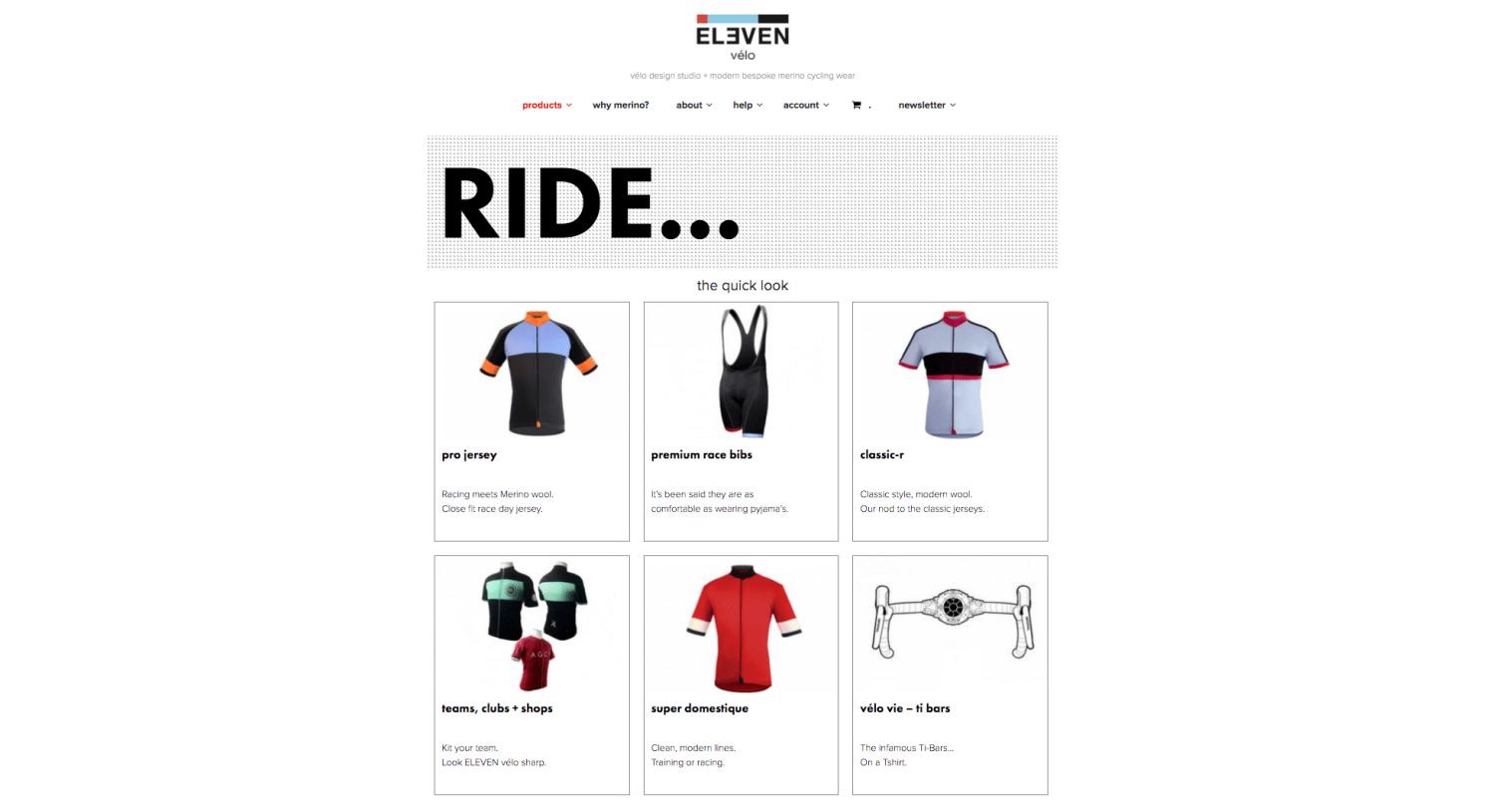
Design-your-own + superfine merino wool, the keys to a unique offering
↑ Back to topAs a small design studio specializing in the cycling sector, ELEVEN vélo is dedicated to the idea that each and every order is unique and specific to the owner. Hands-on in everything we do, each product we design and make passes through our own hands before being handed to its new owner.
Although they started out selling gear for mountain bikers and boutique cycling gear, ELEVEN vélo is now focused on the road riding market. From about 2005, as the market caught up and it became increasingly difficult to compete with the big players, they took a new approach:
We realized if we could make kit on demand, we would be doing something different. We would let people create what they want within a set of constraints, and that way we would develope a business that was very difficult to touch in terms of a competition (without replicating the same pipeline).
The pipeline is not one easily replicated. In fact, Gerard says if someone sat down and tried to formulate a business plan based on what and how ELEVEN vélo does what it does, they’d think they were mad! It’s a delicate production process, requiring strong relationships with various stakeholders and producers.
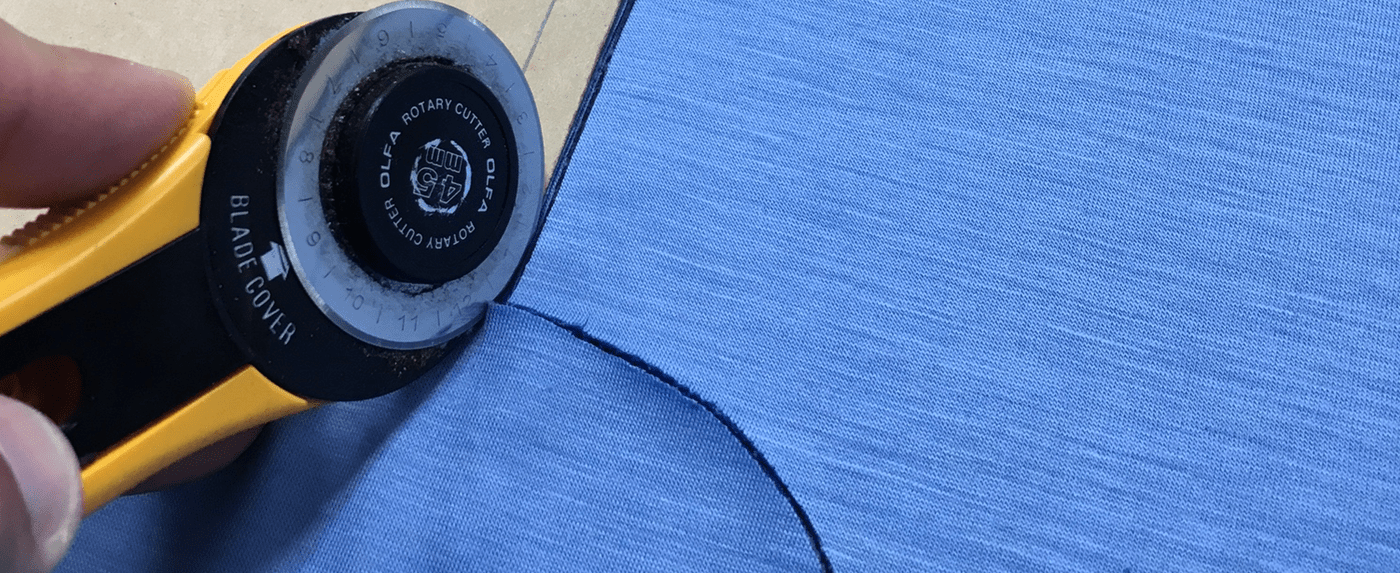
Choosing to manufacture their kit from merino wool was the second smart move Gerard took. As a base material, merino is expensive; when buying the raw material, there’s little price break between small and large scale orders, which levels out the playing field. Plus it’s a controlled supply because there are few producers worldwide making superfine merino.
If someone much bigger comes along, they will never be able to compete on price:
Whether we buy 3m or 100m, the base material is relatively the same price so it levels out the playing field for us. That’s why I pursued the road of the ELEVEN vélo model, fairly safe in the knowledge that if someone tries to compete with us on price they aren’t going to kill us. To date it’s worked!
ELEVEN vélo’s products are durable and hard-wearing, and center around premium ingredients with a known provenance. Their sewing shop is in Sydney, the superfine merino wool they use is from Victoria (Southern Australia), the premium quality threads they use are from Germany, and their Lycra is from Italy. Production is sustainable and adheres to strict environmental practices.
The key? Customers can customize the kit design exactly as they wish. Every order is unique and specific to the owner, and every product made passes through their own hands before shipping.
From custom built color picker to out-of-the-box animation
↑ Back to topSelling bespoke cycling gear online – when people don’t get to try it on – is a tall order. Working around this the store includes detailed sizing information and a color/style “builder” to make ordering a breeze. The builder has been through two iterations, the second of which was a miraculous plug-and-play find from Hype.
Originally when they came up with the idea, they hired a developer to build a jQuery builder. Aside from being a bit convoluted — involving three separate files to make it run and a whole lot of CSS — it worked well, but unfortunately wasn’t responsive. This was increasingly a problem for people shopping on iPads and mobile.
Gerard came across an HTML5 animation builder, Hype, and realized he was able to build the color picker with it. In one quick step they moved to a completely customized solution. It was quite a lot of work integrating into WooCommerce, says Gerard, but is now working a treat.
Adding personalization to the order experience via custom emails
↑ Back to topOffering a bespoke product has obvious benefits, but it is not without its costs. Here, it comes in the form of a painstaking five step production process. Always looking for opportunities to delight customers, ELEVEN vélo cleverly includes them in the production process by way of custom emails.
The team customized and supplemented the standard WooCommerce order emails, drafting messages for each step of production so customers feel part of it. The messages include processing, pipeline, cutting, sewing and order complete.
In the cutting email, customers get a link to check out an Instagram pic of their order — an excellent example of pulling the customer behind the scenes and customizing the experience for them.
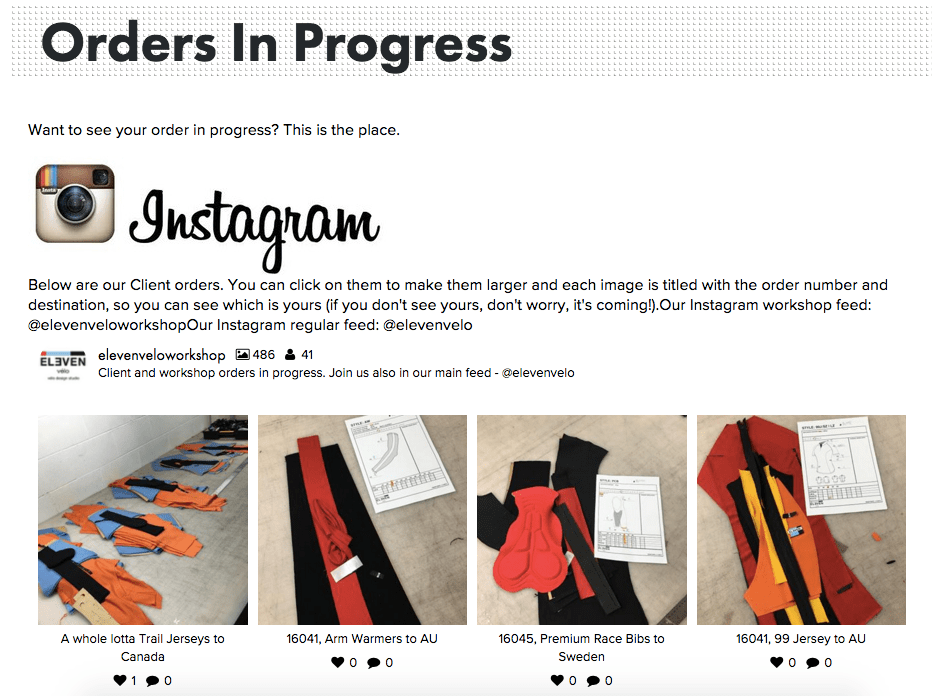
If there are ways to include customers in what goes on behind the scenes, it’s always a win! Especially if it takes a while: orders from ELEVEN vélo take a month to be completed, so including customers along the way is creative way of keeping them engaged.
“Less is more,” applied to SEO and AdWords
Over the years ELEVEN vélo experimented to try and figure out which were the most effective ways to spend their marketing resources.
Print is expensive and the metrics are awful. You spend huge amounts of money and you can’t tell how effective it is. Traditional online media is not much better, again it is very expensive and ROI tends to be fairly poor.
Having experimented with online banners ads and reviews on small to medium-sized blogs, which worked fairly well, they began experimenting with SEO and AdWords mid 2015 and hit a sweet spot: within six months their organic traffic had doubled!
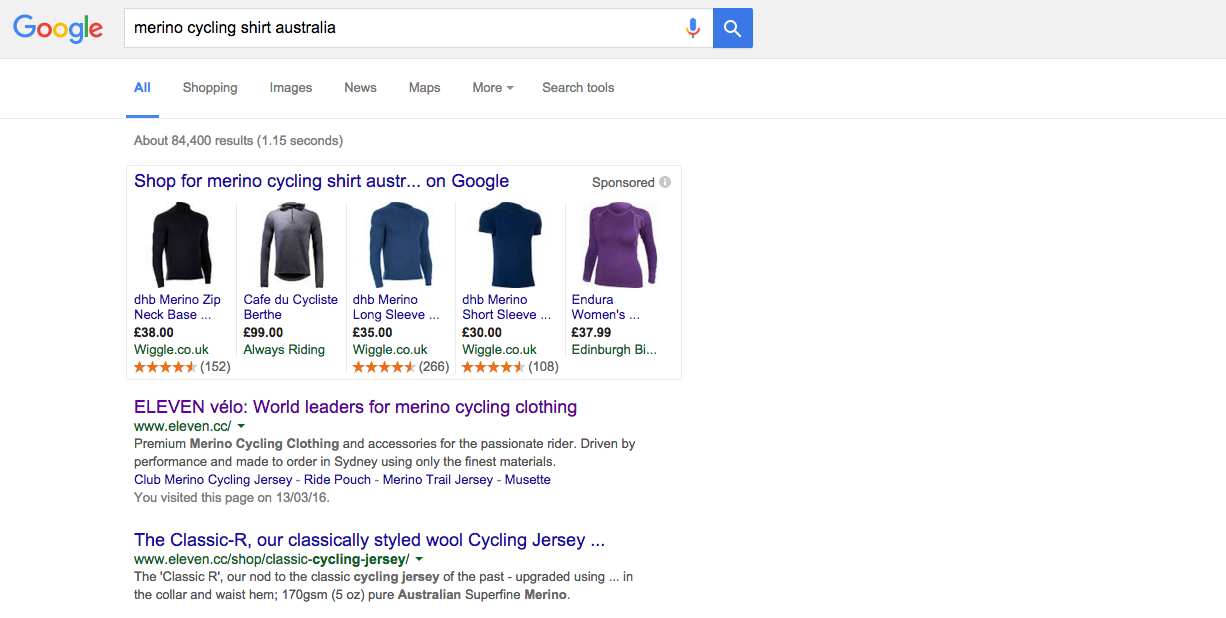
Because they have quite a targeted audience, AdWords proved to be an excellent and effective means to reach potential customers, and the same applied to SEO where they have stripped away everything they could in order to be very direct and specific.
In our site audit this year we decided on a less is more principle. This approach is a battle for SEO — though all our pages do get the Yoast green light rating. Our market is ‘educated’ so giving them a sharp to the point sentence or two and then the product features in a clear and simple manner has turned out to be the best approach.
On copy, content, blogging & social
↑ Back to topConsumers everywhere are saturated with information, and the cycling sector is no different. Everything sold online is heavily driven by marketing, everything has a huge blurb about how fantastic it is, and Gerard reckons there comes a point when people are so saturated that even well-written bodies of text have no effect.
No matter how good your copywriting is, how much more effective is your sales copywriting in a paragraph going to be next to the other company that is also doing a paragraph of well-crafted copy? How about we take away all the marketing fluff and just give them a couple of very succinct sentences with a bunch of bullet points that highlight the product and leave it at that?
Calling all copywriters — Gerard says to curtail that verbose writing! Or even better, leave that for your blog! Knowing what your customers want can make a big difference in how well you sell.
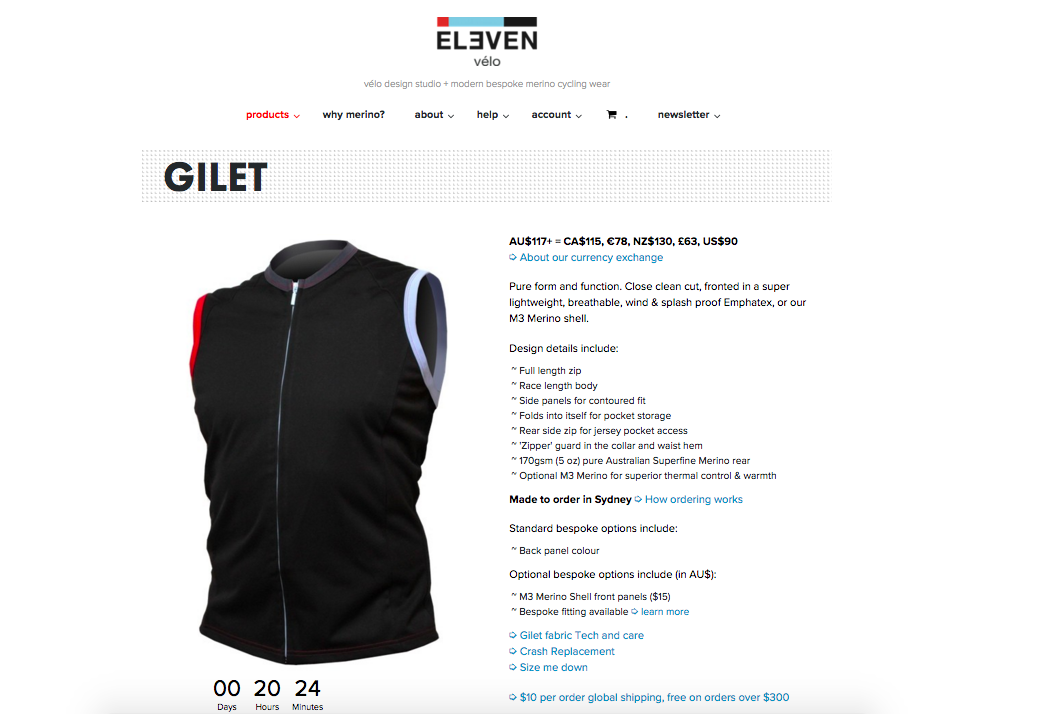
If you are going to commit to a content marketing strategy, Gerard’s advice is to be be prepared to go hard at it because it might end up being as much work as running your business. There aren’t any shortcuts worth taking. Your content represents your brand and you need to treat it with conviction and dedication.
You need to seriously weigh up the ROI. In other words, calculate how much time it takes to create some good content (words, images, whatever), convert that into a monetary value ($/hr), then weigh that against the return you are seeing. You might find paying for more traditional online marketing to be a more effective use of the spend.
Content marketing works best when you have a clear target audience. Doing scattergun efforts and trying to appeal to everyone will ultimately appeal to no one and Gerard recommends first working out if you have a clear and defined audience, then see if you have something to offer that may engage them.
That said, Gerard also cautions store owners shouldn’t be afraid to say no. Content marketing is not for everyone — sometimes it’s just not a realistic option. In this case, he recommends going back to basics and looking at the more “traditional” avenues to market.
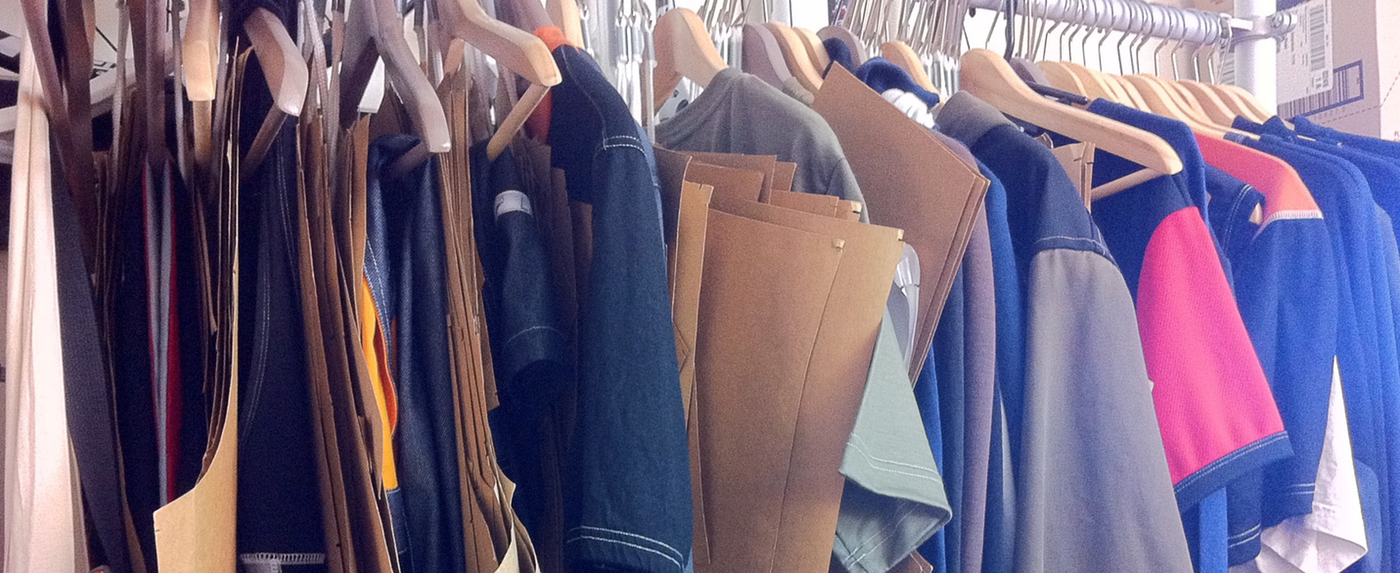
ELEVEN vélo’s blog has a rich history of articles dating back to 2004, all written by Gerard and a friend. The pair spend lots of time around bikes, and as a result the tone of the content is very genuine. They cover everything under the sun, all of which can add values to the lives of their customer’s. For example, how to do strapping.
The consistent voice behind the blog matches that of ELEVEN vélo’s social media, and when one consumes any of their content, it feels as if one is engaging with a real person.
ELEVEN vélo have placed an increasing emphasis on pictures and illustrations, and have even began selling prints or the library of art they have done over the years via a culture mashing sub-site. Their images get tumbled and reblogged quite a bit and have the benefit of an unlimited lifespan. Don’t miss the Japanese animation and cycling mashups, who would’ve thought!
Upping the stakes on Instagram has also proven a good move. Gerard uses Hootsuite to schedule daily posts and attributes much of the brand’s growth to consistent posting.
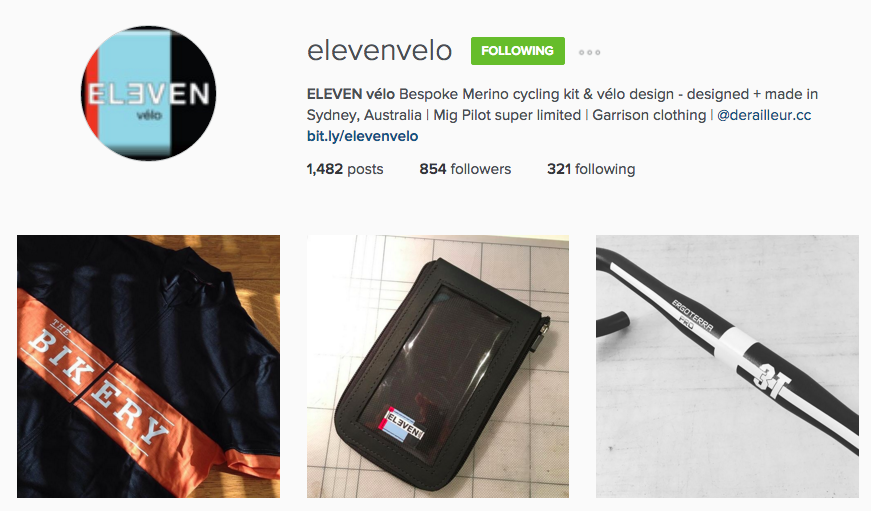
While he reckons it is becoming harder and harder to get traction on Facebook, something Gerard has picked up is that sharing posts to a Facebook page via Instagram consistently gets five times better reach than when posted organically. He’s even tested it, and exactly the same image posted manually performed five times worse. Hot tip!
WooCommerce as a platform, extensions used & hosting tips
↑ Back to topObviously, we’re delighted that Gerard runs ELEVEN vélo on WooCommerce. We asked him his thoughts on our platform and how it has served him over the years:
WooCommerce do well to build something that does so much for so many people. To go in and customize it takes work — it’s daunting to dive in and figure out how it all works, but it was doable. Of course it takes considerable work to make it truly custom, but once you understand how it works and what you need to do, you can find an answer.
Like most store owners, Gerard started out with a lot of plugins or extensions, and has refined his selection down. A sampling of what’s in use on the store:
- An extension to offer bundle-style coupons
- MailChimp integration
- Mijireh payment gateway
- A knowledge base plugin that is used for FAQs
- WooCommerce Points and Rewards
- TablePress, which handles all the size charts for products
- WordFence Security — says Gerard, “if you’re running a site without something for security you’re mad. The number of attempted hacks to get into the backend is really quite disturbing!”
As far as hosting goes, ELEVEN vélo is hosted out of a data farm in Chicago. Gerard has a server with a capacity for 100 sites and pays about $120 monthly, ensuring professional uptime and fast response rates. He says this is vital:
Spending the money on a dedicated server is probably as important as anything else because we need that server serviced and up 100% of the time.
And that’s a wrap
↑ Back to topSpeaking to Gerard was incredibly inspiring and interesting. Hopefully, some of the things he has learned in ecommerce over the past 15 years will serve you well as you power on with your own venture.
Did any tips in particular stand out to you? Anything you disagree with or want to chime in on? Let us know in the comments.
About






Hi,
Very interesting article and company for sure. Few years back I made design-your-own products using product bundles. It works, it was a revolution few years back for sure, but it definitely needs improvements, like using the hype, I find it very interesting but then I read “It was quite a lot of work integrating into WooCommerce, says Gerard, but is now working a treat.” Do you think Woocommerce coule team up with hype somehow or work out a pluggin to make that integration easier? Thank you!
Really glad you enjoyed the article, Matthieu!
It would be great to have an integration with Hype, I’ll pass that feedback on to our product team. You could also nudge Hype yourself, perhaps they’d like to make it 🙂
Matthieu in theory it should be possible to have a Hype file talk to Woo, as you can execute Javascript commands via actions in Hype. That said, the ‘double down’ system that we run, i.e. choose colours via Hype and then input those choices via the Woo menus works as a fail safe, as it forces people to double check their choices before buying. It works very well as we have maybe 1 in a 100 having made a incorrect colour choice.
Sometimes what at first seems less than ideal actually turns out to be the best option for reasons you never thought of at the start!!
You’re the best! Keep on commenting 🙂